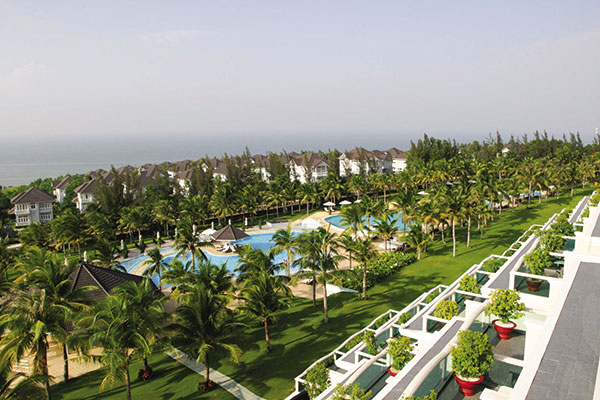Hospitality drives real estate sector
 |
A mix of economic factors, a positive outlook for the real estate sector, and more stable market conditions has led to a rise in regional investor interest in Vietnam’s real estate market.
The hotel and resort sector in particular has been an interesting area for local and international investors. This is due to several factors: a steady increase in international and domestic tourism; the opening of new, internationally-branded properties; energetic construction activity in well-known and newly-established destinations; and an increased number of direct flights from foreign countries. Vietnam welcomed an estimated 7.2 million international visitors in this year’s first nine months, a remarkable 25.7 per cent on-year increase, according to the Vietnam National Administration of Tourism.
According to STR Global, which tracks supply and demand data for the hotel industry, Vietnam in 2016 has proven to be among the best-performing countries globally. As of August, Ho Chi Minh City alone has accounted for a double-digit growth in year-on-year occupancy (up 14.8 per cent, to a 68.0 per cent overall occupancy rate) - with prices rising 5.2 per cent.
Destinations such as Danang and Nha Trang are being set up as regional vacation spots, with direct flights from Singapore, Thailand, China, and South Korea. In addition, emerging destinations such as Phong Nha-Ke Bang National Park in the central province of Quang Binh, which is home to Son Doong - the world’s largest cave, have helped attract more international attention.
These positive indicators have aligned lately, accounting for large increases in investment volume in 2016. At the local level, there have been several land transactions in tourist areas. At the international level, the market has witnessed several acquisitions of operating assets. This year, Vietnam placed an entry in the Asia-Pacific region’s top ten transactions list for the first half of 2016, with the acquisition of InterContinental Asiana Saigon at an estimated $74.9 million. Other large transactions include Ho Chi Minh City’s Duxton Hotel, bought for an estimated $49 million, and the Sedona Suites in Hanoi.
The majority of the acquisitions have been by Singaporean or Hong Kong-owned companies, with long-time experience in Vietnam’s real estate sector. In the resort category, the prime areas of foreign interest are Danang, Cam Ranh, and Phu Quoc. These markets have strong historical growth performance, which presents investors with the prospect of higher returns. After the recent announcement of the rebranding of Hoi An’s The Nam Hai, which is now under Four Seasons management, the Danang area is expected to gain even more attention from international investors.
 |
| Due to many encouraging factors, internationals have been buying into local hospitality Photo: Le Toan |
Foreign investors are mainly attracted to properties already in operation, upscale and higher, located in the central parts of major cities. And recently, foreign investment has begun to target humbler holdings, with private investors exploring mid-range and upper mid-range hotel acquisitions. Ideally, these properties have 100 to 150 rooms, ensuring operating efficiency, with full or select service.
That said, there are a very limited number of quality midscale hotels on the market. The majority of those available for sale are of low-quality design, with reduced potential for rebranding opportunities. We see a potential for local developers willing to undertake greenfield projects to tap into this midscale interest.
International and regional management companies are also actively looking for projects in Vietnam for management or, in certain cases, for lease contracts. In recent years, several management agreements have been signed, including JW Marriott in Phu Quoc and Danang, Sol House by Melia in Phu Quoc, Ibis Style in Nha Trang, Four Points in Danang, Ozo in Hoi An, Melia in Ho Tram, Raddison Blu and Mövenpick in Cam Ranh, X2Vibe in Hoi An, Holiday Inn and Hilton in Ho Chi Minh City, Four Seasons in Danang, and Wyndham in Halong Bay.
Besides operating hotels, foreign investors are interested in condotel projects and beach frontage villas, especially if offered with rental guarantee returns, furnishings, and branded management. Investors in second home units in Vietnam are typically high-income individuals familiar with the country - in some cases with local business commitments or Vietnamese partners.
With approximately 45 projects launched between 2015 and 2016 and more than 15,000 units currently under construction, second home developments have started to play a very important role in the overall real estate market. Among those under construction and available for sale, condotels comprise 76 per cent of the total supply, which indicates a recent favourable trend. However, the condotel still remains a very risky business model, especially if developed by less-experienced developers with no real knowledge of the operational aspect.
To date however, limited sales have been recorded to foreign buyers, with the exception of some well-planned, smaller-scale projects; landed villa-type projects as opposed to high-rise buildings. Developers’ reputations, operations, and designs, together of course with price and location, are still among the most important factors.
Overall, the hospitality market in Vietnam presents clear opportunities for investment. It relies on growing global demand and leverages improvements in the country’s infrastructure, making for a healthy potential for sustainable future growth. Danang has led the way in garnering international investors’ attention in the hospitality market, demonstrating that government authorities can indeed co-operate with private investors on sustainable development.
On the other hand, there will be bumpy rides for some due to short-term oversupply cycles. Investors and developers will need to cope with some cashing in on the market’s healthy outlook as it continues to mature.
What the stars mean:
★ Poor ★ ★ Promising ★★★ Good ★★★★ Very good ★★★★★ Exceptional
Latest News
More News
- Unlocking urban potential of smart cities (December 18, 2025 | 16:50)
- Green finance offers 'passport' for Vietnamese construction, building materials firms (December 15, 2025 | 08:00)
- Gamuda Land commit long-term investment (December 12, 2025 | 11:49)
- HITC ties up with Evolution to develop AI and hyperscale data centres in Vietnam (December 11, 2025 | 12:09)
- Real estate deals boom via high-profile names (December 08, 2025 | 11:32)
- Industrial segment shaped by M&As (December 08, 2025 | 08:00)
- The Privé sets the benchmark for luxury real estate (December 05, 2025 | 08:28)
- TD CASA and the rise of bespoke interior design in luxury living spaces (December 03, 2025 | 14:14)
- Lee Soo-man's Blooming Sky to build Gia Lai culture, sport, and entertainment complex (December 02, 2025 | 16:41)
- Sustainability in DNA of Keppel Vietnam's future urban development strategy (November 28, 2025 | 10:53)
















 Mobile Version
Mobile Version